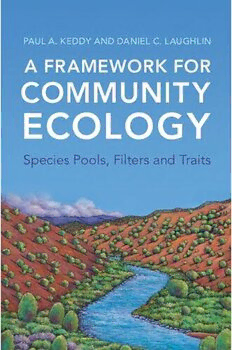Table Of ContentA Framework for Community Ecology
Species Pools, Filters and Traits
This book addresses an important problem in ecology: how are
communities assembled from species pools? This pressing question
underlies a broad array of practical problems in ecology and
environmental science, including restoration of damaged landscapes,
management of protected areas and protection of threatened species.
This book presents a simple, logical structure for ecological assembly
and addresses key areas, including species pools, traits, environmental
filtersandfunctionalgroups.Itdemonstratestheuseoftwopredictive
models (CATS and Traitspace) and consists of many wide-ranging
examples, including plants in deserts, wetlands and forests, and
communitiesoffish,amphibians,birds,mammalsandfungi.Globalin
scope,thisvolumerangesfromthearidlandsofNorthAfrica,toforests
intheHimalayas,totheAmazonianfloodplains.Thereisastrongfocus
on applications, particularly the twin challenges of conserving
biodiversityandunderstandingcommunityresponsestoclimatechange.
PaulA.Keddyisanindependentresearcherwhohastaughtcommunity
ecology for more than 30 years. Paul has conducted award-winning
research on environmental factors controlling plant communities and
theirmanipulationtoenhancenativebiodiversity.Hedelightsinbring-
ingsciencealiveforhisaudience.Theauthorofsixbookswinningthree
scientific prizes, he also co-edited Ecological Assembly Rules:
Perspectives,AdvancesandRetreats(CambridgeUniversityPress1999).
Daniel C. Laughlin is a professor of plant ecology and ecological
modelling in the Department of Botany at the University of
Wyoming. Daniel’s research focuses on developing quantitative
approachestounderstandandpredicthowplantspeciesandcommu-
nities respond to global change. His lab develops trait-based models
thattranslateecologicalprocessesintostatisticalframeworkstopre-
dict how communities assemble along environmental gradients and
howspeciesinteractatlocalscales.
.
.
A Framework for
Community Ecology
Species Pools, Filters and Traits
paul a. keddy
Independentscholar
daniel c. laughlin
UniversityofWyoming
.
UniversityPrintingHouse,CambridgeCB28BS,UnitedKingdom
OneLibertyPlaza,20thFloor,NewYork,NY10006,USA
477WilliamstownRoad,PortMelbourne,VIC3207,Australia
314–321,3rdFloor,Plot3,SplendorForum,JasolaDistrictCentre,
NewDelhi–110025,India
103PenangRoad,#05–06/07,VisioncrestCommercial,Singapore238467
CambridgeUniversityPressispartoftheUniversityofCambridge.
ItfurtherstheUniversity’smissionbydisseminatingknowledgeinthepursuitof
education,learning,andresearchatthehighestinternationallevelsofexcellence.
www.cambridge.org
Informationonthistitle:www.cambridge.org/9781316512609
DOI:10.1017/9781009067881
©PaulA.KeddyandDanielC.Laughlin2022
Thispublicationisincopyright.Subjecttostatutoryexception
andtotheprovisionsofrelevantcollectivelicensingagreements,
noreproductionofanypartmaytakeplacewithoutthewritten
permissionofCambridgeUniversityPress.
Firstpublished2022
PrintedintheUnitedKingdombyTJBooksLimited,PadstowCornwall
AcataloguerecordforthispublicationisavailablefromtheBritishLibrary.
ISBN978-1-316-51260-9Hardback
ISBN978-1-009-06831-4Paperback
CambridgeUniversityPresshasnoresponsibilityforthepersistenceoraccuracyof
URLsforexternalorthird-partyinternetwebsitesreferredtointhispublication
anddoesnotguaranteethatanycontentonsuchwebsitesis,orwillremain,
accurateorappropriate.
.
Contents
Preface pageix
1 AGeneralFrameworkforCommunityEcology 1
Communities 1
AGroundinginReality 3
CompositionandCausalFactorsCanBothBeMapped 8
TheLanguageofSamplesandSampleUnits 9
MoreGeneralPrinciples:AssemblyandResponse 10
TheStudyofPatternIsNottheStudyofCommunity
Assembly 13
FoundationsofCommunityEcologyLaidbyRaunkiaer 15
AGeneralFramework 18
TheBasicElementsofCommunityEcology 19
Summary 34
KeyPointsoftheChapter 39
2 Filters 41
ThePowerofFilters 41
DroughtActsasaFilter 43
ColdActsasaFilter 47
HypoxiaActsasaFilter 49
SalinityActsasaFilter 55
HerbivoresActasFilters 57
WildfiresActasFilters 60
PredatorsasFiltersinFrogCommunities 61
PredationasaFilter 63
HowManyFiltersDoWeNeed? 65
MoreonExperimentsandFilters 69
v
.
vi contents
Conclusion:TheUbiquityandPowerofFilters 74
KeyPointsoftheChapter 75
3 SpeciesPools 76
TheListofParts 76
TypesofPools 81
SomeTheoryaboutPoolsandCommunities 88
RatesofArrivalandDepartureintheCommunity 91
SomeEmpiricalRelationshipsObservedinReal
Communities 97
ExperimentalManipulationofImmigrationand
EstablishmentfromPools 102
InvasiveSpeciesandthePotentialSpeciesPool 104
ApproachestoMeasuringPools 105
MoreonOlderListsandTheirUtilityinDocumentingSpecies
Pools 114
LookingAhead 120
KeyPointsoftheChapter 124
4 Traits 125
NamingSpecies 125
ABiologicalParadox:TwoSystemsforOneReality 131
FunctionalClassifications:SomeHistoricalContext 133
MorphologicalTraitsinBirds:BillsAreFundamental 135
PlantFunctionalTraits 139
TheFundamentalGlobalTrait:LeafEconomics 144
GettingtheWatertotheLeaves:TraitsforWater
Conduction 147
TraitsandTraitMatrices 149
Traits,EnvironmentsandApplications 163
KeyPointsoftheChapter 164
5 Trait–EnvironmentInteractions 165
ThePowerofFilters 165
.
contents vii
Overview:QuantifyingTrait–Environment
Relationships 167
StaticAbundance-BasedApproaches 169
MoreontheFourthCornerProblem 171
AnExamplefromaWetland 178
DynamicFitness-BasedApproaches 183
Conclusion 186
KeyPointsoftheChapter 189
6 FunctionalGroups 190
FurnitureAssembly 190
FunctionalClassificationforEcologicalPrediction 195
FunctionalGroupsinPlants 197
FunctionalGroupsinBirds 207
FunctionalGroupsinInsects 209
FunctionalTypesofFish 210
FunctionalTypesofMammals 218
FunctionalTypesofFungi 218
SomeMethodologicalIssues 221
OntheRealityofFunctionalGroups 224
TheUnderlyingCausesofFunctionalGroups 226
FunctionalGroups,TraitMatricesandEcological
Assembly 228
KeyPointsoftheChapter 230
7 PredictiveModelsofCommunityAssembly 232
PredictioninCommunityEcology 232
CommunityAssemblybyTraitSelection 233
HowManyTraitsAreEnough? 243
TheTraitspaceModelofEnvironmentalFiltering 244
ApplyingtheTraitspaceModeltoConiferForests
inSouthwesternNorthAmerica 253
ApplyingBothCATSandTraitspacetoaKettlehole
Wetland 256
.
viii contents
RelaxingtheAssumptionofaSingleOptimal
TraitValueUsingTraitspace 257
SomeConcludingRemarksonTwoModelsforCommunity
Assembly 260
KeyPointsoftheChapter 263
8 ProspectsandPossibilities 265
LogicalStructureforCommunityEcology 265
Species,FunctionalGroupsandCommunityAssembly 266
TheCanonicalModelforCommonnessandRarity:Lessonsfor
CommunityAssembly 283
ResponseRulesandInertiainCommunityAssembly(Time
Dependence) 306
TheRoleofCausalFactorsinEcologicalCommunitiesand
Restoration 311
KeyPointsoftheChapter 319
References 320
Index 350
.
Preface
Beforedivingintothefirstchapter,takeamomenttoenjoytheacrylic
paintingRamblingRioGrandebyJohnathanHarris,reproducedon
thecoverofthisbook.Thisiconicdepictionofthearidsouthwestern
USAillustratesmanyofthethemesinthisbook.
Let’sstartattheriverandworkourwayupinelevation.The
riparianzoneattheriver’sedgeisdominatedbyfast-growingplant
species.Eventhoughthesurroundingregionishighdesert,the
communityofriparianplantsthrivesinthefluvialsedimentsthat
havebeendepositedneartheedgeoftheRioGrande.Thisvegetation
consistsofwetsedgemeadowsandcottonwoodforestswith
understoriesofCoyoteWillow(Salixexigua),Seepwillow(Baccharis
wrightii),andIndigoBush(Amorphafruticosa).Yet,outsidethe
floodplain,soilmoistureplummets,andtheseriparianspeciesare
replacedbyPinyon–Juniperwoodlands.PinyonPine(Pinusedulis)and
One-seedJuniper(Juniperusmonosperma)areshorttreesthattolerate
dryconditionsbecauseofthephysiologicalpropertiesoftheirleaves
andwood–thatis,their“traits.”Climbingtheelevationgradient
further,weenteranarrowbandofmixedforestdominatedby
PonderosaPine(Pinusponderosa),DouglasFir(Pseudotsuga
menziesii)andQuakingAspen(Populustremuloides).Thistallerand
denserforestissupportedbysummerthunderstormsanddeeper
snowpack.Beyondthetreelineinthepurplemountains,cushion
plantslikeMossCampion(Sileneacaulis)andotheralpinespecies
toleratethewind,thebittercoldwinters,andtheshortgrowing
seasons.Thus,thispaintingdepictsdistinctcommunitiesthatarise
alongoneelevationgradient.
Thegoalofthisbookisnotmerelytodescribesuchpatterns,but
tolayoutageneralcausalframeworkthatexplainshowtheyarise.
Boththecausalframeworkforecologicalcommunities,andthe
ix
.

